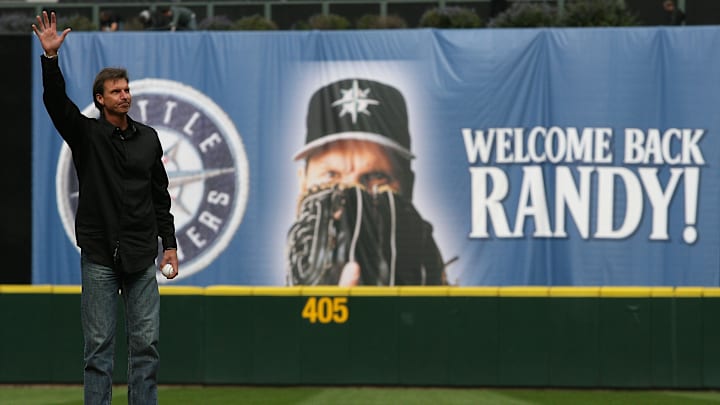1997
The Blue Jays made the splash of the ‘97 offseason when they signed Roger Clemens away from divisional rivals the Boston Red Sox. Clemens went on to win the Cy Young Award with some of the best numbers in his career. He posted a career high 292 strikeouts in 264 innings with a 2.05 ERA and an 11.9 bWAR. Johnson posted numbers that were just behind Clemens’ output. The “Big Unit” had a 2.28 ERA in 213 innings with 291 strikeouts and finished second in the Cy Young voting.
The Blue Jays went 76-86 finishing fifth in the AL East. Their run differential was only -40 with 694 runs allowed, and 654 runs scored. If we remove the worst pitcher from the Blue Jays rotation in Robert Person (5.61 ERA, 80 earned runs in 128.1 innings) and plug in Johnson’s numbers the Blue Jays run differential is +26. Maybe that’s enough to win a few more games and finish third in the AL East instead of right at the bottom.
It would have been tough to top the 98 win Orioles and the 96 win Yankees, but maybe they would have been better than the Tigers and the Red Sox who won 79 and 78 games respectively.
You could also make the argument that the Blue Jays would have been even better than that as the top four in the rotation would have consisted of not just Johnson and Clemens, but Hentgen and Woody Williams who both had good years.
Hentgen accumulated a 5.8 bWAR pitching to a 3.63 ERA while tying Clemens in complete games (9) shutouts (3) and innings pitched (264). He had a 123 ERA+ and a 2.25 K/BB rate. Williams was worth 3.1 bWAR with a 4.35 ERA, throwing 194 innings with 124 strikeouts a 104 ERA+.
The bullpen was also solid that season. They finished with the fifth best ERA of 3.77, giving up the second least earned runs in the American League (163) and the second least home runs allowed (43).
The Blue Jays had the makings of a good pitching team in 1997 that would have only been better had Johnson been plugged into the equation.
1998
In 1998, the Blue Jays finally had a winning season finishing 88-74. While they were 26 games behind the AL East division winning Yankees, they were just four back of the Red Sox who clinched the lone wild card spot. They were largely carried by their offense which scored 816 runs but their pitching also carried their own.
In a year that was dominated by offensive statistics, the Blue Jays staff may not have included guys whose numbers jumped off the page (outside of Clemens 8.1 bWAR and 2.65 ERA) but four of their five main starters were pretty much league average, or just slightly better and that might have been enough to surpass the Red Sox.
If the Blue Jays could have plugged Johnson into this rotation they would have gotten a good, but not elite pitcher. Johnson was having a tough time in this offense friendly environment in 1998, as he owned a 4.33 ERA with the Mariners through 23 games, before he was traded to Houston. However, down the stretch with the Astros, he had a 1.28 ERA in 11 games, with 116 strikeouts in 84.1 innings. His overall numbers of a 3.28 ERA with 329 strikeouts and a 5.7 bWAR, would have been second best behind Clemens in the Blue Jays rotation.
Regardless of Johnson not being his elite self that season, those numbers may have given the Blue Jays the edge over the Red Sox who had just slightly better pitching statistics than Toronto at the end of the season. The Red Sox had a 4.18 team ERA (second in the AL) while the Blue Jays' owned a 4.28 (third in the AL). They were also second and third respectively in earned runs (667 for Boston, 697 for Toronto), WHIP (1.33 for Boston, 1.39 for Toronto) and batting average against (.255 for Boston, .256 for Toronto). The margin for victory could not have been any closer between these division rivals in '98, and one solid pitcher could have made all the difference.
However, even if Toronto made the postseason, it's unlikely anyone was stopping the 114-win Yankees that year who went on to sweep the World Series against the San Diego Padres, winning their first of three straight championships, and second in three seasons to that point. But that's not to say strange things can't happen in the playoffs, as the 92-win Red Sox were dumped in four games in the ALDS against the 89-win Cleveland Guardians.
What we’ve learned from this experiment is that by plugging Johnson statistics into the Blue Jays rotation from 1993-1998, the closests they would have come to earning a playoff birth would have been in 1998, and they also would still have been favourites to win the World Series in 1993.
But from 1994-1997 the Blue Jays would have needed more help than just Johnson, despite his impressive accolades. While it’s not a true to life study and there would have been so many other factors weighed into this regarding Johnson’s performance and his overall numbers, the fact remains a trade for “The Big Unit” in 1993 would have altered both his and the Blue Jays’ history.
